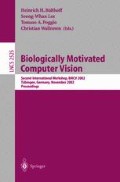Abstract
In this paper, we propose a scene-centered representation able to provide a meaningful description of real world images at multiple levels of categorization (from superordinate to subordinate levels). The scene-centered representation is based upon the estimation of spatial envelope properties describing the shape of a scene (e.g. size, perspective, mean depth) and the nature of its content. The approach is holistic and free of segmentation phase, grouping mechanisms, 3D construction and object-centered analysis.
Access this chapter
Tax calculation will be finalised at checkout
Purchases are for personal use only
Preview
Unable to display preview. Download preview PDF.
References
Barnard, K., Forsyth, D.A.: Learning the semantics of words and pictures. Proceedings of the International Conference on Computer Vision, Vancouver, Canada (2001) 408–415
Barrow, H. G., Tannenbaum, J.M.: Recovering intrinsic scene characteristics from images. In: Hanson, A., Riseman, E. (eds.): Computer Vision Systems, New York, Academic press (1978) 3–26
Biederman, I.: Recognition-by-components: A theory of human image interpretation. Psychological Review. 94 (1987) 115–148
Carson, C., Belongie, S., Greenspan, H., Malik, J.: Blobworld: Image segmentation using Expectation-Maximization and its Application to Image Querying. IEEE Transactions on Pattern Analysis and Machine Intelligence. 24 (2002) 1026–1038
Gershnfeld, N.: The nature of mathematical modeling. Cambridge university press (1999)
Heaps, C., Handel, S.: Similarity and features of natural textures. Journal of Experimental Psychology: Human Perception and Performance. 25 (1999) 299–320
Henderson, J.M., Hollingworth, A.: High level scene perception. Annual Review of Psychology. 50 (1999) 243–271.
Marr, D.: Vision. San Francisco, CA. WH Freeman (1982)
Oliva, A., Schyns, P. G.: Diagnostic color blobs mediate scene recognition. Cognitive Psychology. 41 (2000) 176–210.
Oliva, A., Torralba, A.: Modeling the shape of the scene: a holistic representation of the Spatial Envelope. International Journal of Computer Vision. 42 (2001) 145–175
Potter, M. C.: Meaning in visual search. Science. 187 (1975) 965–966.
Rao, A.R., Lohse, G.L.: Identifying high level features of texture perception. Graphical Models and Image Processing. 55 (1993) 218–233
Rensink, R. A., O'Regan, J. K., Clark, J. J.: To see or not to see: the need for attention to perceive changes in scenes. Psychological Science. 8 (1997) 368–373
Rogowitz, B., Frese, T., Smith, J., Bouman, Kalin, E.: Perceptual image similarity experiments. Human Vision and Electronic Imaging, SPIE Vol 3299. (1998) 576–590
Schyns, P.G., Oliva, A.: From blobs to boundary edges: evidence for time-and spatial-scale dependent scene recognition. Psychological Science. 5 (1994) 195–200
Szummer, M., Picard, R. W.: Indoor-outdoor image classification. IEEE InternationalWorkshop on Content-based Access of Image and Video Databases, Bombay, India (1998)
Torralba, A.: Contextual Modulation of Target Saliency. In: Dietterich, T. G., Becker, S, Ghahramani, Z. (eds.): Advances in Neural Information Processing Systems, Vol. 14. MIT Press, Cambridge, MA (2002)
Torralba, A., Oliva, A.: Depth estimation from image structure. IEEE Transactions on Pattern Analysis and Machine Intelligence. 24 (2002)
Torralba, A., Sinha, P.: Statistical context priming for object detection: scale selection and focus of attention. Proceedings of the International Conference in Computer Vision, Vancouver, Canada (2001) 763–770.
Vailaya, A., Jain, A., Zhang, H. J.: On image classification: city images vs. landscapes. Pattern Recognition. 31 (1998) 1921–1935
Author information
Authors and Affiliations
Editor information
Editors and Affiliations
Rights and permissions
Copyright information
© 2002 Springer-Verlag Berlin Heidelberg
About this paper
Cite this paper
Oliva, A., Torralba, A. (2002). Scene-Centered Description from Spatial Envelope Properties. In: Bülthoff, H.H., Wallraven, C., Lee, SW., Poggio, T.A. (eds) Biologically Motivated Computer Vision. BMCV 2002. Lecture Notes in Computer Science, vol 2525. Springer, Berlin, Heidelberg. https://doi.org/10.1007/3-540-36181-2_26
Download citation
DOI: https://doi.org/10.1007/3-540-36181-2_26
Published:
Publisher Name: Springer, Berlin, Heidelberg
Print ISBN: 978-3-540-00174-4
Online ISBN: 978-3-540-36181-7
eBook Packages: Springer Book Archive

